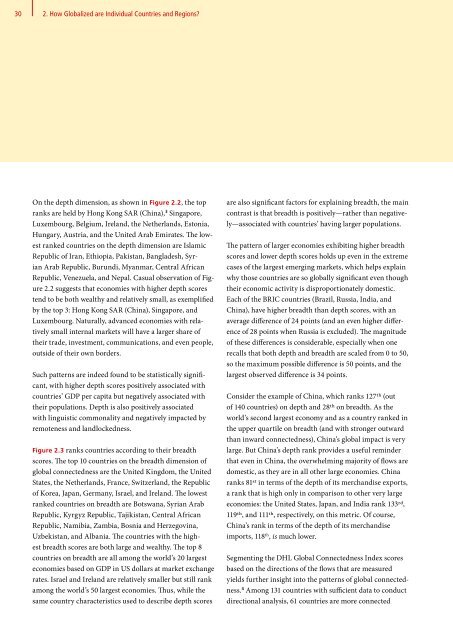DHL Global Connectedness Index 2014
DHL Global Connectedness Index 2014
DHL Global Connectedness Index 2014
- No tags were found...
Create successful ePaper yourself
Turn your PDF publications into a flip-book with our unique Google optimized e-Paper software.
30 2. How <strong>Global</strong>ized are Individual Countries and Regions<br />
On the depth dimension, as shown in Figure 2.2, the top<br />
ranks are held by Hong Kong SAR (China), 3 Singapore,<br />
Luxembourg, Belgium, Ireland, the Netherlands, Estonia,<br />
Hungary, Austria, and the United Arab Emirates. The lowest<br />
ranked countries on the depth dimension are Islamic<br />
Republic of Iran, Ethiopia, Pakistan, Bangladesh, Syrian<br />
Arab Republic, Burundi, Myanmar, Central African<br />
Republic, Venezuela, and Nepal. Casual observation of Figure<br />
2.2 suggests that economies with higher depth scores<br />
tend to be both wealthy and relatively small, as exemplified<br />
by the top 3: Hong Kong SAR (China), Singapore, and<br />
Luxembourg. Naturally, advanced economies with relatively<br />
small internal markets will have a larger share of<br />
their trade, investment, communications, and even people,<br />
outside of their own borders.<br />
Such patterns are indeed found to be statistically significant,<br />
with higher depth scores positively associated with<br />
countries’ GDP per capita but negatively associated with<br />
their populations. Depth is also positively associated<br />
with linguistic commonality and negatively impacted by<br />
remoteness and landlockedness.<br />
Figure 2.3 ranks countries according to their breadth<br />
scores. The top 10 countries on the breadth dimension of<br />
global connectedness are the United Kingdom, the United<br />
States, the Netherlands, France, Switzerland, the Republic<br />
of Korea, Japan, Germany, Israel, and Ireland. The lowest<br />
ranked countries on breadth are Botswana, Syrian Arab<br />
Republic, Kyrgyz Republic, Tajikistan, Central African<br />
Republic, Namibia, Zambia, Bosnia and Herzegovina,<br />
Uzbekistan, and Albania. The countries with the highest<br />
breadth scores are both large and wealthy. The top 8<br />
countries on breadth are all among the world’s 20 largest<br />
economies based on GDP in US dollars at market exchange<br />
rates. Israel and Ireland are relatively smaller but still rank<br />
among the world’s 50 largest economies. Thus, while the<br />
same country characteristics used to describe depth scores<br />
are also significant factors for explaining breadth, the main<br />
contrast is that breadth is positively—rather than negatively—associated<br />
with countries’ having larger populations.<br />
The pattern of larger economies exhibiting higher breadth<br />
scores and lower depth scores holds up even in the extreme<br />
cases of the largest emerging markets, which helps explain<br />
why those countries are so globally significant even though<br />
their economic activity is disproportionately domestic.<br />
Each of the BRIC countries (Brazil, Russia, India, and<br />
China), have higher breadth than depth scores, with an<br />
average difference of 24 points (and an even higher difference<br />
of 28 points when Russia is excluded). The magnitude<br />
of these differences is considerable, especially when one<br />
recalls that both depth and breadth are scaled from 0 to 50,<br />
so the maximum possible difference is 50 points, and the<br />
largest observed difference is 34 points.<br />
Consider the example of China, which ranks 127th (out<br />
of 140 countries) on depth and 28th on breadth. As the<br />
world’s second largest economy and as a country ranked in<br />
the upper quartile on breadth (and with stronger outward<br />
than inward connectedness), China’s global impact is very<br />
large. But China’s depth rank provides a useful reminder<br />
that even in China, the overwhelming majority of flows are<br />
domestic, as they are in all other large economies. China<br />
ranks 81st in terms of the depth of its merchandise exports,<br />
a rank that is high only in comparison to other very large<br />
economies: the United States, Japan, and India rank 133rd,<br />
119th, and 111th, respectively, on this metric. Of course,<br />
China’s rank in terms of the depth of its merchandise<br />
imports, 118 th , is much lower.<br />
Segmenting the <strong>DHL</strong> <strong>Global</strong> <strong>Connectedness</strong> <strong>Index</strong> scores<br />
based on the directions of the flows that are measured<br />
yields further insight into the patterns of global connectedness.<br />
4 Among 131 countries with sufficient data to conduct<br />
directional analysis, 61 countries are more connected





